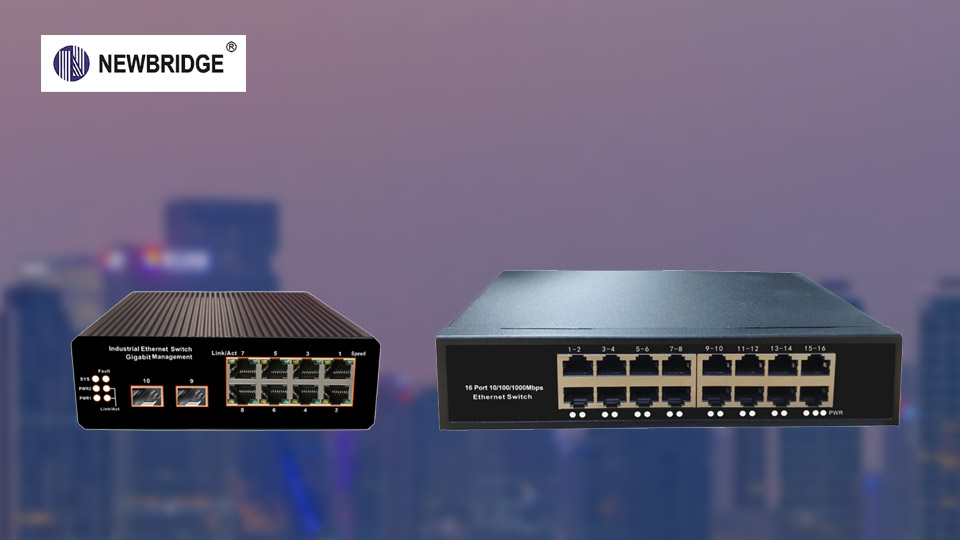Compared industrial switches with ordinary switches from five key aspects

1、 Application environment
The application environment of industrial switches is vastly different from that of ordinary switches. Industrial switches are mainly used in industrial scenarios such as factory workshops, mines, and transportation hubs, which are often accompanied by extreme temperature changes. For example, in some steel plants, the temperature may reach over 50 ℃, and in northern mines, the winter temperature may drop below -40 ℃. At the same time, there is also a large amount of dust, oil pollution, and strong vibration. Ordinary switches are usually deployed in environments such as offices, homes, and commercial buildings, where the temperature is generally controlled between 0 ℃ -40 ℃, the environment is clean and tidy, and there is almost no vibration or dust impact. Industrial switches need to work stably in harsh environments, so environmental adaptability should be fully considered in their design, while ordinary switches focus more on the user experience in comfortable environments.
2、 Performance requirements
In terms of performance requirements, there are significant differences between the two. In industrial environments, the stability and real-time performance of data transmission are crucial. For example, in industrial automation production lines, real-time communication between equipment directly affects production efficiency and product quality. Industrial switches typically have higher data processing speeds and more stable bandwidth, capable of supporting high-speed data transmission. Their data transmission rates can reach gigabit or even ten gigabit, and they can still maintain low latency and packet loss rates under high load conditions. Ordinary switches are mainly used for daily network connections, such as web browsing, file transfer, etc. They do not have high requirements for real-time data transmission. Although they can also meet basic network needs, their performance is relatively weak when processing large amounts of data or tasks that require high real-time performance.
3、 Reliability
Reliability is one of the important differences between industrial switches and regular switches. Industrial switches adopt various reliability designs to ensure long-term stable operation in industrial environments. For example, using redundant power supply design, when one power supply fails, the other power supply can immediately take over to ensure that the equipment is not powered off; Equipped with redundant fans, even if one fan is damaged, other fans can still work normally to ensure the cooling effect of the equipment; In terms of hardware design, high-quality electronic components and sturdy casings are used to enhance the impact and interference resistance of the equipment. Ordinary switches usually adopt a single power supply and simple heat dissipation design, with relatively less investment in reliability. Once a power failure or heat dissipation problem occurs, it is easy to cause equipment shutdown and affect network connectivity.
4、 Functional Features
In terms of functional features, both have their own emphasis. Industrial switches have unique features designed to meet the special needs of industrial scenarios. For example, it supports multiple industrial communication protocols such as PROFINET, MODBUS TCP, EtherCAT, etc., making it easy to connect and communicate with industrial equipment; It has functions such as port aggregation, VLAN partitioning, QoS (Quality of Service), etc., which can manage and control network traffic, ensuring priority transmission of critical business data. The functions of ordinary switches are relatively simple, mainly supporting general network protocols such as TCP/IP, with basic port connections and data exchange functions, suitable for meeting the network needs of ordinary users. However, there is insufficient support for special communication protocols and complex network management requirements in industrial environments.
5、 Protection level
The protection level is an important indicator for measuring the protective ability of equipment in harsh environments. Industrial switches usually have high protection levels, such as IP40, IP67, etc. IP40 indicates that the device is capable of preventing solid foreign objects with a diameter greater than 1.0mm from entering, while also possessing a certain level of splash proof capability; IP67 indicates that the device is completely dust-proof and will not affect normal operation even if immersed in water for a certain period of time. This level of protection can effectively protect industrial switches from operating normally in harsh environments such as dust, humidity, and excessive water. The protection level of ordinary switches is generally low, usually IP20, which can only prevent solid foreign objects with a diameter greater than 12.5mm from entering, and can only meet the protection requirements of ordinary environments such as offices. In industrial environments, they are easily affected by factors such as dust and moisture, leading to equipment failures.
